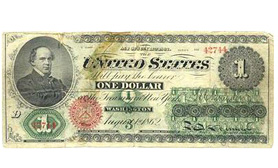Greenback dollar History
Greenback got its name from a slang term for U.S. paper dollars due to their color, however, in the mid-1800s, “greenback” was a negative term. During this time, the Continental Congress did not have taxing authority. As a result, the greenback did not have a secure financial backing and banks were reluctant to give customers the full value of the dollar.
Half a century later all the foreign coins and competing state currencies were finally out of circulation, but by the early 1800s, the U.S. was ready to try the paper money experiment again. Bank notes had been in circulation for a while, but because banks issued more notes than they had coin to cover, these notes often traded at less than face value.
During the 1860s, the U.S. created over $400 million in legal tender to finance its war against itself. These were called greenbacks simply because the backs were printed in green. The government backed this currency and stated that it could be used to pay back public and private debts. The value fluctuated according to the North’s success or failure at certain stages in the war. Confederate dollars, also issued during the 1800s, followed the fate of the confederacy and were worthless by the end of the war and only the greenback prevailed.




